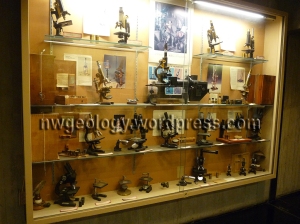The corridor geology exhibits at WWU’s Geology Department features a new diorama by Marlin Peterson. He earlier painted a Diatryma to go along with the giant bird’s footprint on display.(time lapse video of his effort painting the giant bird). The new painting is on the first floor of the ES building, just beyond the western set of elevator doors.
Marlin’s painting is of an Eocene tapir protecting its baby from a hunting pack of creodonts. Footprints of both have been found in the Chuckanut Formation, most recently in the rubble of the Racehorse Creek landslide (where the Diatryma tracks came from, too), and the fossil tracks of both are mounted on the wall next to the new mural. (I’ll be featuring the WWU geology museum in my book, Geology Underfoot in Western Washington. The chapter is written, and has been reviewed by George Mustoe and Keith Kemplin).

More cool stuff in the WWU Geology Museum. This is a collection of petrologic microscopes. These are on the ground floor.
It’s a treat to visit Marlin’s website to see what else this talented artist has done. Though he is traveling in Indonesia right now, having all manner of incredible adventures swimming with manta (ooooh, funny, MS Word tells me this should be ‘mantra’) rays and barracudas and fighting leeches to climb volcanoes in the jungle, Marlin will eventually drag himself back to paint a gigantic wall mural in Tacoma featuring a daddy long legs spider. Scroll down on his website to read about the grant he received to do this, and to see an idea he has for the painting. Marlin has some great stuff posted on his website, be sure to scroll down further. The one that caught my eye was near the bottom, a painting of a monkey being carried across the Atlantic on a fallen tree back in the Oligocene (23-34 million years ago). Fascinating to read Marlin’s account of this theory for the radiation of “old” world monkeys to the “new”. Curious we still use those relativistic terms, when all the continents were once agglomerated into Pangea.
The WWU Geology Museum is in the corridors of the Environmental Studies building, on the Ground, First, and Second floors. It is open to the public 7 days a week while classes are in session. On weekends, you may need to enter on the First Floor off Haskell Plaza, at the building’s NW corner.
Filed under: Chuckanut Formation, fossils | Tagged: Chuckanut Formation, creodont, diatryma, Eocene, flightless bird, Fossils, Geology Underfoot in Western Washington, Marlin Peterson, Western Washington University geology | 4 Comments »



